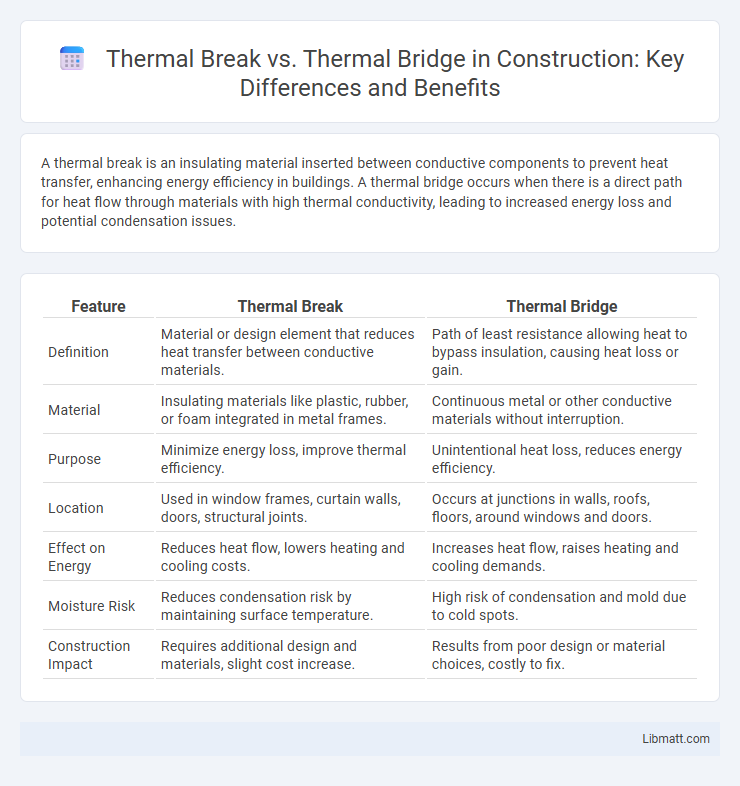A thermal break is an insulating material inserted between conductive components to prevent heat transfer, enhancing energy efficiency in buildings. A thermal bridge occurs when there is a direct path for heat flow through materials with high thermal conductivity, leading to increased energy loss and potential condensation issues.
Table of Comparison
| Feature | Thermal Break | Thermal Bridge |
|---|---|---|
| Definition | Material or design element that reduces heat transfer between conductive materials. | Path of least resistance allowing heat to bypass insulation, causing heat loss or gain. |
| Material | Insulating materials like plastic, rubber, or foam integrated in metal frames. | Continuous metal or other conductive materials without interruption. |
| Purpose | Minimize energy loss, improve thermal efficiency. | Unintentional heat loss, reduces energy efficiency. |
| Location | Used in window frames, curtain walls, doors, structural joints. | Occurs at junctions in walls, roofs, floors, around windows and doors. |
| Effect on Energy | Reduces heat flow, lowers heating and cooling costs. | Increases heat flow, raises heating and cooling demands. |
| Moisture Risk | Reduces condensation risk by maintaining surface temperature. | High risk of condensation and mold due to cold spots. |
| Construction Impact | Requires additional design and materials, slight cost increase. | Results from poor design or material choices, costly to fix. |
Introduction to Thermal Breaks and Thermal Bridges
Thermal breaks are insulating materials installed between conductive building components to prevent heat transfer, significantly improving energy efficiency and reducing condensation risks. Thermal bridges occur when materials with high thermal conductivity create a path for heat flow, leading to energy loss and cold spots within building envelopes. Understanding the difference between thermal breaks and thermal bridges helps you optimize insulation strategies for enhanced thermal performance in your construction projects.
Understanding Thermal Bridging in Building Design
Thermal bridging occurs when conductive materials create a path for heat flow, bypassing insulation and causing energy loss and potential condensation issues in building envelopes. Thermal breaks are specially designed materials or components that interrupt this heat flow, improving thermal performance by reducing heat transfer through structural elements. Understanding and addressing thermal bridging is critical in building design to enhance energy efficiency, maintain indoor comfort, and prevent moisture-related damage.
What Is a Thermal Break?
A thermal break is a material or component with low thermal conductivity inserted between building elements to prevent heat transfer and reduce energy loss. Unlike a thermal bridge, which creates a path for heat flow, a thermal break disrupts this path, enhancing insulation and improving your building's overall energy efficiency. Proper use of thermal breaks in construction minimizes condensation and temperature fluctuations inside structures.
Key Differences Between Thermal Breaks and Thermal Bridges
Thermal breaks are materials with low thermal conductivity designed to interrupt heat flow and improve energy efficiency in building structures, whereas thermal bridges are pathways, often metal or structural elements, that conduct heat and cause energy loss. The key differences lie in their purpose and impact: thermal breaks actively reduce heat transfer, while thermal bridges unintentionally facilitate it, leading to potential condensation and increased heating or cooling costs. Understanding and addressing these concepts can optimize Your building's thermal performance and reduce energy expenses.
Energy Efficiency: Impact of Thermal Breaks vs. Thermal Bridges
Thermal breaks significantly enhance energy efficiency by interrupting the conductive path of heat flow, reducing heat loss in building envelopes and lowering energy consumption for heating and cooling. In contrast, thermal bridges create continuous pathways for heat transfer, resulting in increased energy waste, higher utility bills, and potential condensation issues. Implementing thermal breaks in construction materials improves insulation performance and contributes to sustainable building design by minimizing thermal bridging effects.
Common Materials Used for Thermal Breaks
Common materials used for thermal breaks include polyamide, polyurethane, and fiberglass-reinforced plastics, prized for their low thermal conductivity and durability. These materials effectively reduce heat transfer between conductive building components, enhancing energy efficiency. You can improve your building's insulation performance by selecting thermal breaks made from these innovative and reliable materials.
How Thermal Bridges Affect Indoor Comfort
Thermal bridges create pathways for heat to escape, leading to cold spots on interior surfaces that can cause drafts and uncomfortable temperature variations in your living space. These unwanted heat losses increase energy consumption as heating or cooling systems work harder to maintain a consistent indoor climate. Addressing thermal break solutions reduces these heat transfer points, enhancing indoor comfort and energy efficiency.
Solutions to Minimize Thermal Bridging
Thermal bridging occurs when heat bypasses insulation through conductive materials, causing energy loss and condensation issues. Solutions to minimize thermal bridging include using thermal break materials like insulated spacers, continuous insulation layers, and advanced framing techniques to reduce direct conductive paths. Your building's energy efficiency improves significantly by integrating these strategies to maintain consistent thermal barriers and prevent unwanted heat transfer.
Thermal Breaks in Windows, Doors, and Façades
Thermal breaks in windows, doors, and facades significantly reduce heat transfer by interrupting the conductive path between interior and exterior elements, enhancing energy efficiency and indoor comfort. Unlike thermal bridges that create unwanted heat flow and condensation risks, properly designed thermal breaks improve insulation performance and prevent cold spots. Your building's overall thermal performance depends on integrating high-quality thermal breaks to minimize energy loss and reduce heating and cooling costs.
Choosing the Right Thermal Solution for Your Project
Thermal breaks and thermal bridges play critical roles in managing heat transfer in construction, with thermal breaks serving as insulating barriers that reduce heat flow, while thermal bridges allow unwanted heat conduction through structural elements. Choosing the right thermal solution for your project depends on factors such as building design, climate conditions, and energy efficiency goals. Implementing effective thermal breaks can significantly enhance insulation performance, reduce energy costs, and prevent condensation issues in your structure.
Thermal break vs Thermal bridge Infographic

 libmatt.com
libmatt.com